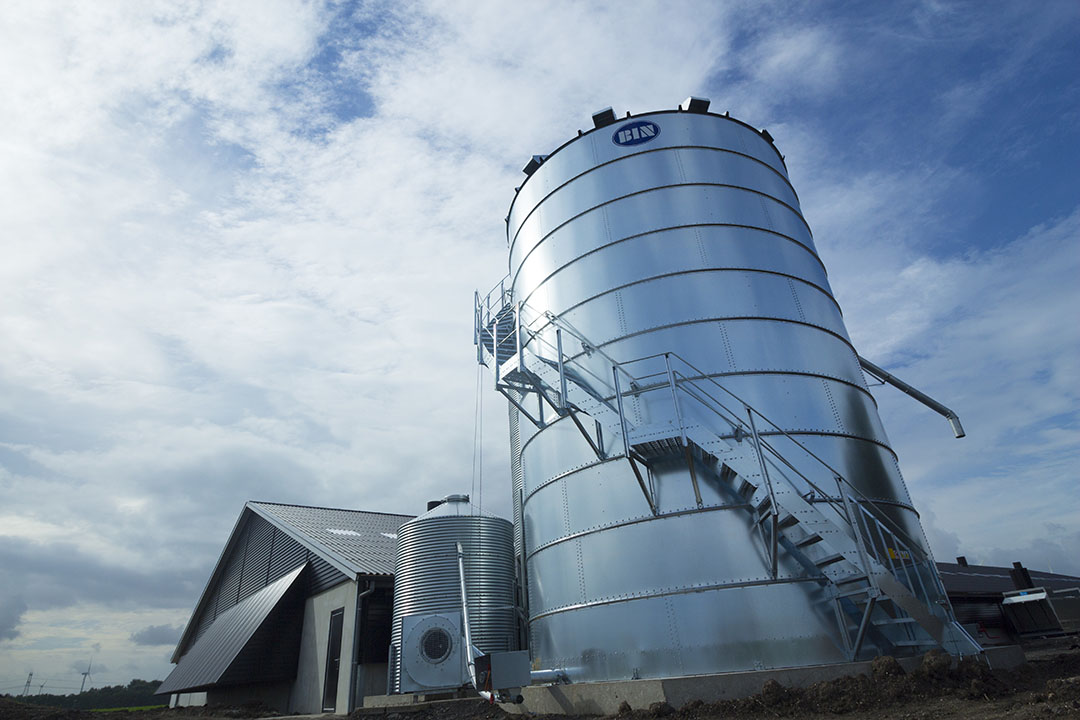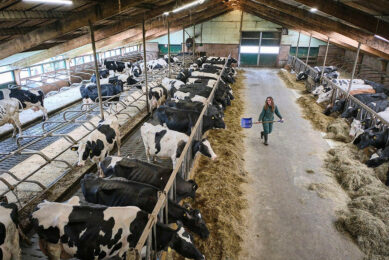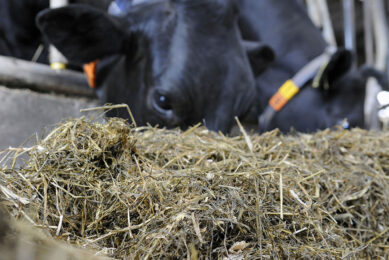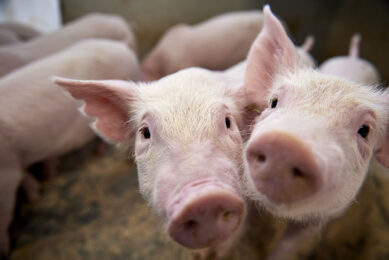Feed management to increase profits

We all know that proper management of feed leads to reduced feed costs and improved production efficiency and profitability of farms. Here we review some of the strategies that can help farmers reach these goals.
Several feed management strategies can be done by farmers and these can be employed either jointly or severally, depending on farm resources, management policies, and the mode of production.
Hay management
Field drying of hay is often associated with quality losses due to weather conditions, leaching, leaf loss, etc. This is particularly true with legume crops which are more sensitive to field losses than grasses and may lose up to 30% and 40% of their dry matter (DM) and protein contents, respectively. Such losses affect the amount of hay available and hence prompt the need for using extra amounts of grains and protein supplement, thereby making the hay feeding programme costly. The use of chemical drying agents such as potassium carbonate can improve the drying rate of the cell wall of the stem material by breaking the waxy layer of the outer stem so that moisture can escape. This enables the stem to dry about as quickly as the leaf, i.e. the treated hay requires 34 hours to dry to 75% DM, while untreated hay requires more than 50 hours to dry. In this way, the chemical treatment can reduce the possibility of field losses by up to 70%, which makes it cost effective. Baling is also a factor contributing to the loss of hay quality. When using a large round baler, the losses will be higher compared to using a large square/rectangular baler.
In one study, pick-up losses from a large round baler ranged from 0.5-11.0% but were only 0.5-5.0% for rectangular balers. The large round baler also had higher chamber losses, from <5.0-17%, compared to 2.0-5.0% for the rectangular baler. if a choice was made to purchase the hay instead of making it on the farm, then it is important to have the results of nutrient analysis. the analysis provides the best opportunity to make the proper management decision based on the specific cattle nutrient needs and price. by “guessing” at the quality, one could be making a serious mistake and end up compromising cattle performance or costing much more than it should.>
Table 1 gives an example of a price comparison of 2 hays priced at $ 95/ton delivered. The comparison needs to be done on a dry matter basis for protein and energy, simply by taking the as-is price divided by the percent dry matter to achieve price per ton of DM. The DM price is then divided by percent nutrient on a DM basis to arrive at the price per unit of nutrient. In this situation, whether additional protein or energy is needed, hay (A) is the best option on a cost per unit of nutrient basis.
Silage system
The silage system selected affects production costs and farm profitability (Table 2). The data show that the most economical silage system for a 100 cow dairy farm was a bagged silage method, followed by the stave silos and wrapped bale silage, with the uncovered bunker silo being the least profitable storage method.
The difference here may be attributed to the following factors:
- The magnitude of exposure to mould damage and/or aerobic deterioration of silage,
- The nutritive losses which cause a drop in milk production, or otherwise necessitate additional supplements to meet the herd energy and protein requirements,
- The reduced nutritive content in manure which caused an increase in fertiliser use and
- The change of the machinery operating costs, the use of fuel and electricity, labour costs, and storage costs.
Manipulation of concentrate ingredients
Field studies in Bangladesh have shown that inclusion of 8% broiler offal in place of fish meal has decreased feed cost per kg from 53.21 TK with fish meal to 45.77 TK with broiler offal (TK stands for Bangladeshi taka, and is equal to about US$ 0.013 ). In other studies conducted at the University of Georgia, USA, it has been demonstrated that peanut meal could be used at 5% of the total ration in place of soybean meal as an attempt to reduce feed costs (US$ 140/ton for peanut meal vs US$ 225/ton for soybean meal). The only source of concern about the peanut meal is its possible contamination with aflatoxins. However, when 5% peanut meal is used in the ration, the level of aflatoxins in the mixed feed would be much too low to be of practical concern. Currently, work is undergoing worldwide to examine the potential of other unconventional feed resources and their impacts on animal production. Examples of such resources include kitchen disposals, poultry litter, fruit and vegetable processing wastes, etc. Although promising results have so far been obtained with most of these feeds, further work is still needed to ascertain their economic feasibility under practical farm conditions. Also some of these ingredients are not allowed in animal feed in the EU.
Supplementation
One practice greatly overlooked by cow-calf producers is simply forage testing. It’s extremely difficult to decide whether to utilise a protein supplement or an energy supplement or a mineral supplement without knowing the nutritional value of the forage. For example, wintering a set of cows on a forage that tests 8% protein or higher does not require additional supplemental protein, provided the cows are on a full-feed of tins forage. In contrast, when the protein levels fall below 8%, then it is important to utilise a protein supplement. During periods of cold or wet weather, we need to feed an energy (grain) supplement, since the energy requirements are increased by cold weather. When lower quality’ forage is fed or grazed, the ideal combination is to feed a protein supplement that will meet the cow’s protein requirement, but also add energy to the diet. In contrast, when the forage tests over 8% protein, it will generally be economically advantageous to use simply grain supplementation which can often be provided to the cows at approximately a third to half the cost of feeding a protein supplement.
Protected protein and protected fat
A study was conducted in India on crossbred dairy cows fed typical rations containing corn, clover, sugar cane, wheat bran, and groundnut cake over a period of 90 days. The cows were divided into 4 groups (A control group receiving untreated ration, a group receiving protected protein, a group receiving protected fat, and a group receiving protected protein with protected fat) to determine the effects of the treatments on performance and economic returns of milk production (Table 3).
There was a slight increase in the feed cost due to the treatment, but the net return per animal has increased due to the increase in milk yields and milk fat. The supply of protected protein and protected fat has probably increased the availability of amino acids and energy to animal and has thus affected milk production performance. Also, supplementation of protected protein and fat may have reduced the detrimental effects of negative energy balance and has thus increased lactation performance and economic returns of the milk produced.
Control of mycotoxins
The most obvious economic impacts of mycotoxins will occur at the feedstuff producer level where losses will include yield losses, increased production cost, increased marketing risks, and costs and increased post-harvest costs. Price discounts could be substantial depending on the level of contamination and the supply of and demand for the contaminated commodity. Producers feeding their own heavily contaminated crops to their own livestock, rather than taking price discounts or destroying or treating them, could compound losses to the farm operation. They can also suffer the loss of a customer or an entire market if the quality and dependability of their product come into question.
The consumer costs could include higher product prices as some increased costs faced by handlers and processors are passed on to consumers or as supplies are restricted. Consumers could also be faced with a less nutritious feed supply and debilitating effects of mycotoxicosis if the contaminated feedstuff were to enter the feeding system. These problems can be alleviated with proper forage management, as indicated above. Proper storage of grains is also an important factor in preserving the quality of feed and protecting them from mould damage. Field studies in Egypt have revealed that in most farms, the feed is stacked under shelters where it can frequently be subject to mould damage and invasion from rodents, wild birds and/or insects. Much of these problems could have been alleviated if the feed was stored in silos. It was estimated that the cost of 20-ton silo can be recovered in just 3 years as a result of savings of up to 16,000 Egyptian Pounds per year being the value of the feed damaged under the current poor storage conditions. The use of additives such as mould inhibitors, mycotoxin binder, and/ or antioxidants may also provide a solution to most mould problems.

Control of rodent infestation
Rodent infestation of farms does not only affect farm facility (water pipes, electrical wires, drainage system, etc.) but also interferes with feed utilisation. A 250g rat can eat its own weight in a day (about 90 kg/rat/year). This means that a farm with a total population of 50 rats, for example, could simply lose tons of feed each year. Such problems can be eliminated from the start by means of rodent proof constructions, sanitation, and use of rodenticide such as anticoagulants (e.g. warfarin, pindone, and chlorophacinone), and non-anticoagulants (e.g. bromethalin, zinc phosphides, and cholecalciferol). Trapping can also be an effective approach to rodent control and can result in a reduction of up to 70% of the rodent population, provided that an adequate number of traps is available and that access to the feed storage areas is prevented.
References are available upon request.











